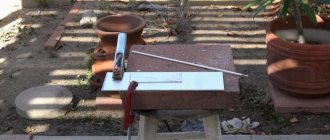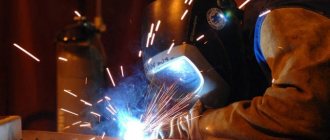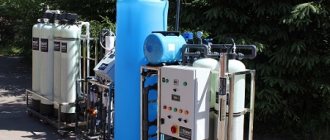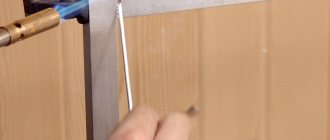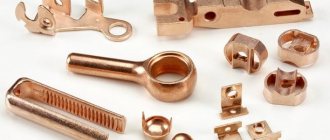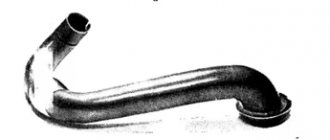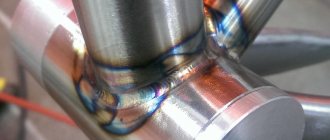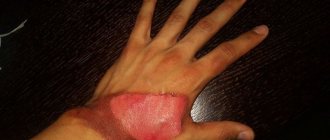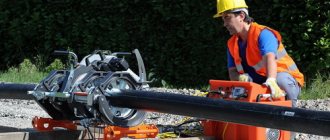As a rule, special equipment and special technologies are most often used for welding aluminum structures and parts. Welding using manual arc welding is quite difficult . But sometimes it is necessary, and we will help you figure out how to weld aluminum structures with electrodes.
When working with aluminum, the following types of welding are mainly applicable:
- MMA (manual arc welding of aluminum (see electrodes for aluminum));
- MIG (semi-automatic aluminum welding);
- TIG (welding of aluminum in an argon atmosphere using filler wire).
We will not touch upon the topic of agro-arc welding or the use of tungsten electrodes. Below we will talk about carrying out welding work with simple manual coated arc welding electrodes .
Aluminum electrode welding (MMA)
MMA (Manual Metal Arc) - manual arc welding with coated electrodes. This method is far from the most effective when working with aluminum products. Disadvantages of manual arc welding:
- it is difficult to make an even seam;
- the seam may be porous and not very durable;
- when the electrode melts, strong spattering is observed;
- It is difficult to clean the seam from slag.
And yet, despite the listed disadvantages, there are situations when manual arc welding cannot be done without . MMA welding can be used to connect aluminum structures that do not bear heavy loads . The minimum metal thickness must be no less than the thickness of the electrode (4 mm).
Manual arc welding with coated electrodes is useful at home when it is not possible to use bulky and expensive equipment .
Welding with inverter
Why, if there are no options other than MMA, is it then recommended to weld aluminum with an inverter? Although welding aluminum with electrodes is a rather complicated process, there is a way to make your life a little easier. Aluminum is a poorly weldable metal, so to achieve an even and high-quality weld, you should use an inverter.
Of course, there are other techniques that can be used in manual arc welding: rectifiers, transformers or generators. However, an inverter is the most profitable option due to the following advantages:
- High efficiency - up to 95% and above. The high-frequency pulse semiconductor converter completely eliminates inductive losses.
- Efficient energy consumption . The inverter automatically turns off when operation stops.
- Protection from unstable electrical network . The inverter produces the required voltage regardless of network sags. The pulse converter automatically adjusts to the input voltage and provides the required output parameters.
- Precise adjustment of welding current . The current required for specific welding jobs directly depends on the thickness of the electrodes used. The inverter control knob allows you to set the desired value before starting work.
- Quick arc ignition . It is quite easy to hit the part with an electrode. The inverter ensures stable combustion of the welding arc.
- Convenient to use at home . Inverters, as a rule, have compact dimensions. For comparison, a welding transformer with a power of 8 kW weighs more than 40 kg, while an inverter of the same power weighs less than 5 kg.
Processing aluminum with an inverter - specifics of the work
Due to the fact that the argon environment provides protection from oxygen exposure, aluminum welding with an inverter is sometimes called gas welding.
Inert gases prevent the appearance of an oxide film, so argon or a mixture of argon and helium is used for gas protection.
The use of such a mixture is relevant for gas protection of thick layers of metal.
Argon arc welding is possible only with alternating current and occurs as follows: an electric arc is ignited between a non-consumable electrode located in the torch and the surface to be welded.
In this case, the supply of inert gas is also provided by a torch, the nozzle of which is located in the welding zone, just like the main consumable material - filler wire.
IMPORTANT TO KNOW: Tips for soldering copper pipes with your own hands
Video:
The oscillator is responsible for igniting the arc, since the properties of the inert gas prevent the arc from being connected by touch.
After the gas leaves the nozzle and surrounds the electrode, the metal melts and a weld pool with liquid aluminum is formed.
Then, the filler wire enters the weld pool. It is important that this welding element is of the same brand as the main part being welded.
Therefore, before starting argon welding, you need to determine the required grade of filler wire.
This parameter depends on the chemical composition of the metal being welded.
For example, if the diameter of aluminum is from 2 to 5 mm, wire of the AD, AK or AO grade is used.
The seam should be applied slowly and gradually, thoroughly welding the part.
It is unacceptable to stop the gas supply immediately after completing the seam - it is better to delay the process for a few seconds to prevent possible cracking of the seam or its deformation.
To better protect the seam, the burner is moved after the filler rod. The electrode and the rod must not move crosswise.
Video:
Experienced welders recommend heating the part to be welded not only before, but also after welding, after which it is necessary to provide thermal and mechanical auxiliary measures.
By carefully regulating the torch operating process and following the specified sequence, the welding results will show a strong connection and a neat, high-quality seam.
To understand the intricacies of the work process, we suggest watching a video about welding work with aluminum in our article.
Features of the technology
Let's look at the features of aluminum electrode welding technology. Manual arc welding of aluminum is not the most convenient process, so it is important to know and take into account some features of welding.
- Selecting Electrodes.
First of all, you need to select the appropriate type of electrodes. The fact is that some brands have a coating intended only for working with aluminum alloys. Others are used exclusively for welding pure aluminum. Therefore, this parameter should be taken into account. Electrode manufacturers indicate the purpose of a specific brand, so you can easily choose the right one. - Surface cleanliness . When welding with electrodes, preparation of the surface of the structure is of great importance. It should be well processed so that the seam is smooth and durable.
- Current _ Aluminum welding is carried out using direct current of reverse polarity. This is due to the fact that an oxide film forms on the surface of this metal. And with reverse polarity, the film is destroyed using cathode sputtering.
[ads-pc-2][ads-mob-2]
Chemical properties of aluminum
Aluminum is characterized by high solubility of hydrogen in liquid form with low solubility at the crystallization point. This directly affects the quality of welding work. If even a small amount of hydrogen dissolves in the weld metal, the weld may become porous , as the hydrogen will tend to escape.
Another important chemical property of aluminum is oxidation . The combination with oxygen creates aluminum oxide, which forms a kind of film on the surface of the metal. On the one hand, the oxide film reliably protects the metal from corrosion. On the other hand, it becomes an obstacle to welding work . While aluminum already melts at 660.3°C, the melting point of the oxide film is 2037°C.
Mechanical properties of aluminum
The strength, elasticity and elongation of the weld depend on the type of alloy from which the parts are made, as well as on the composition of the electrode.
The strength of the welded joint will be quite weak in cold-hardened alloys. To achieve good weld strength in heat-resistant alloys, longer heat treatment times and slow cooling are required. IMPORTANT! Aluminum has good thermal conductivity, so it is recommended to use heat-dissipating pads when carrying out welding work. This will help preserve the remaining parts of the workpieces from shrinkage and deformation.
Use of alloying components
To improve the quality of the weld, the following alloying additives can be used in aluminum electrodes:
- Manganese (Mn) - increases corrosion resistance.
- Silicon (Si) - reduces the melting of aluminum, improves fluidity and weldability.
- Magnesium (Mg) - gives the metal excellent weldability and good strength. When combined with silicon, it forms a heat-resistant alloy.
Electrodes OK AlMn1 (96.20) containing manganese
Important tips for welders
According to experienced specialists, electric welding of such flexible metal without the use of argon is sometimes carried out as well as with argon welding. If someone dissuades you from such a decision, arguing that it is of poor quality of the final seam and poor weldability, do not believe it. Most likely, he approached the method incorrectly or never tried to weld aluminum using an electrode .
To avoid irreparable mistakes and unpredictable troubles, it is enough to follow a number of recommendations and rules:
- The butt joint method is considered the most promising. Other types in the form of a T-weld or lap welded joint are impractical, since they increase the likelihood of slag flowing into the gaps, which will cause a corrosion reaction.
- After welding operations, the seam is washed with water to clean the workpiece from slag.
- Immediately before processing, the material must be properly prepared. To do this, remove the oxide film and prevent its appearance in the future.
- When welding massive parts with a thickness of three millimeters or more, it is necessary to separate the edges at an angle of 60 degrees with a V-shape.
- Primary heating of aluminum is carried out at 150−250 degrees Celsius.
Do not forget that technically pure aluminum can be welded much better than alloys containing magnesium or manganese . We are talking about duralumin or silumin. However, products made from pure material are practically not used, so some difficulties may arise during welding.
Which electrodes are better
A few words about which electrodes are best for welding with aluminum electrodes. For manual arc welding of aluminum structures, consumables from the Ozana-2 brand are often used. Among the advantages of electrodes of this brand:
- ensure stable arc burning;
- the seam is well formed in any position (including vertical);
- slag formations on the working surface are easily separated;
- the weld seam has good mechanical properties.
Swedish electrodes are also widely used. Consumables with alkali-salt coating are optimally suited for welding structures made of technical aluminum, as well as aluminum alloys with manganese or magnesium.
You can read more about choosing electrodes for aluminum welding here. [ads-pc-3][ads-mob-3]
Difficulties of the process
Let's look at the complexities of the electrode welding process on aluminum. The difficulty of manual welding of aluminum structures is largely due to the properties of this metal. Below are examples of the main problems that may arise during the welding process.
- High metal fluidity . Molten aluminum is difficult to control. With significant overheating, the behavior of the metal becomes somewhat unpredictable. The melt can destroy the layer of solid metal underneath and flow out through the crack. To solve this problem, it is recommended to use ceramic or refractory steel gaskets .
- Oxidability of aluminum . The main problem of aluminum products. Combining with oxygen, metal molecules form a dense oxide film. It is stronger than the metal itself and melts only at very high temperatures. Another disadvantage is that the film is a dielectric, so it is difficult to ignite an arc. To solve this problem, you need to thoroughly clean the metal working surface before welding .
- High coefficient of linear expansion . Aluminum is quite fragile and has low elasticity. When the metal is very hot, the welding zone puts pressure on the rest of the structure, which can cause cracks or deformation of flat surfaces. To avoid this, you need to control the welding temperature . It’s better to preheat the part to 200-250°C.
- When the weld metal hardens, it can crystallize and hot cracks appear . Therefore, it is advisable to add a special filler material. This is especially necessary in cases where several seams are located at a short distance from each other.
Useful video
Watch the video where the craftsman argues that welding aluminum with an electrode is not the best solution and demonstrates the process clearly, with explanations.
How to cook correctly: technique, stages and nuances
Now let's figure out how to weld aluminum structures using conventional coated electrodes, and what is required for this.
First stage: preparatory
Before starting welding, it is necessary to carry out preparatory work to clean the surface from dirt and oxide film. This is necessary in order to ensure good weldability of the metal and the formation of a high-quality seam. Sequencing:
- Pre-cleaning . Any detergent + stiff brush. The metal is then washed with clean cold water.
- Then the surface needs to be degreased . Organic solvents are suitable for this: white spirit, acetone, etc.
- If the part is small, it can be placed in an alkaline bath for a few minutes . The temperature of the solution must be greater than 60°C.
- After this, the surface must be sanded with a wire brush . Do not use abrasive agents, as particles of the working layer may remain on the surface.
- The metal is then washed with a solvent . It cannot be wiped off, must dry on its own.
Stages of welding activities
Understanding the key intricacies of aluminum welding is not as difficult as it might seem at first glance. Through numerous attempts and experiments, you can achieve successful results and learn such a skill by heart. So, step-by-step actions for high-quality joining of metal products consist of the following stages and features:
- If the thickness of the plate being welded exceeds 5 millimeters, it is necessary to cut the edges. To do this, it is recommended to cut the edges at an angle of 45 degrees, although other values are also allowed. It is no secret that the width of the weld seam depends on the size of the cutting angle. If the thickness of the plates exceeds 7 millimeters, then you will have to make a technical gap between each part of two millimeters. If the work object is represented by a crack, then it is widened using a cutting disc and a grinder. Otherwise, the seam will be superficial.
- The prepared workpiece is thoroughly heated. A propane-oxygen flame is used to remove excess liquid. The role of the working tool is performed by a cutter or an ordinary can with a household torch. It is necessary to warm the surface to 150 degrees and make sure that the material is dry enough.
- After thoroughly warming up, it is necessary to clean the oxide film. In this case, you can use a regular brush to clean the metal. It is important to remove the refractory layer at the beginning of the welding zone. The following actions are carried out using an electrode, the composition and temperature of which can corrode the oxide and re-weld.
- Tacks are installed on the prepared product, which secure all parts to be welded. The root seam should be smooth and completely fill the gap. The angle relative to the parts being welded must be at least 90 degrees. This may seem unusual to inexperienced welders, or those who have had to work with carbon steels. However, in this way the molten metal will more accurately fall into the joint. After the surface cools, the slag falls off. Unfortunately, this action is carried out with great difficulty, so you cannot do without a sharp hammer.
- The next layers of the seam are applied until the entire thickness is filled.
Preparatory actions
Regardless of the welding conditions - industrial or home, you need to properly prepare the edges of the workpiece . Such an action consists of the following processes:
- The surface of the part that will be welded (as well as the surface of the filler material) is thoroughly cleaned of dirt, oil and grease. To degrease the surface, white spirit, acetone, aviation gasoline and many other solvents are used.
- The preparatory stage also includes such actions as cutting the edges of welded parts, which is performed only when absolutely necessary. If you do not use coated electrodes when welding, then edge cutting is carried out when the thickness of the parts being joined exceeds 4 millimeters. If the thickness of the aluminum alloy exceeds 20 mm, then the use of electrodes is indispensable. If aluminum sheets up to 1.5 millimeters thick can be welded, then their ends are pre-flanged before joining.
- As mentioned above, immediately before welding, the surface of the part must be completely cleaned of the oxide film. In this case, it is common practice to use a high-quality file or a bristle brush to clean the metal. In some cases, a thin layer of oxide film is also removed using special chemicals, such as caustic soda, gasoline and others. When treating with caustic soda, the workpiece must be thoroughly rinsed with running water .
Equipment and electrodes
Pay attention to the list of the most necessary tools and accessories . In most cases, the operation is carried out using a conventional inverter. This device has a convenient design, so it is easy to move or move around the workshop. The polarity is set in such a way that the “plus” is placed in the worker’s hands, and the “minus” affects the workpiece. In this case, you need to get a 220 V outlet.
When choosing electrodes, you should give preference to specialized models such as UTP 48 or similar analogues. They can have different diameters and be selected taking into account the thickness of the metal. The composition of consumable raw materials also has some hygroscopic properties, so it must be pre-dried to ensure a better connection .
